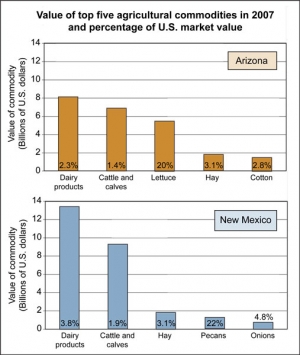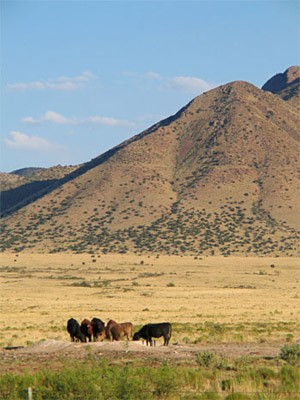Agriculture
More than 35 percent of Arizona’s land1 and almost 60 percent of New Mexico’s land is used for farming and ranching. Thus climate change-related impacts on the Southwest landscape will most likely have significant impacts on the Southwest’s agricultural sectors. Changes in water availability, vegetation cover, carbon dioxide levels, and frequency of extreme events like flood, drought, or frost will impact crop and forage production, increasing costs for both producers and consumers.

Figure 1. Value of top five agricultural commodities in 2007 and percentage of U.S. market value.
| Enlarge This Figure |
Credit: Gigi Owen, CLIMAS, The University of Arizona
In New Mexico, agriculture comprises a $1.7 billion annual industry, around three-quarters of which is from livestock. Major crops include forage crops, onion, pecans, and wheat. In Arizona, agriculture is approximately a $2.4 billion annual industry, with over one-third in livestock. Major crops include forage crops, cotton, lettuce, and wheat (see Figure 1). Climate change could cause a reduction of the number of farmed acres in New Mexico by 20 to 25 percent and in Arizona by 4 to 20 percent.
Climate change will have broad implications for agriculture in the Southwest, including:
- Cattle ranching
- Crop farming
- Demand for water, including changes in groundwater recharge and streamflow
- Carbon dioxide fertilization in plants
- Increase in weeds, pests, and disease
- The geography of agricultural production
- Management and decision making
Cattle ranching
Ranching suffers during drought because most ranchers do not irrigate their pastures but instead rely on rainfall. Without rain, less forage grows and what does grow is often poor quality. Ranchers must decide how many cattle their range can support at a given time.

Ranchers typically do not irrigate pastures and rangeland. A warmer and possibly drier climate will likely affect rangelands for cattle across the region.
Credit: ©Jill Fromer, istockphoto.com
With little forage, they may be forced to sell cattle or buy supplemental hay and alfalfa. If ranchers must thin their herds, they often sell at a low price, creating a market surplus of cows that drives down the price of beef. Once ranchers are ready to buy cows again, cattle are often in short supply and more expensive.
Less rainfall means less drinking water for cattle, which can lead to delays in breeding and development. Due to these delays and a lack of forage, calves and cows may be sold between 10 and 100 pounds lighter than normal. Higher temperatures in summer can suppress cattle appetites, leading to lower bodyweight and decreased milk production. On a positive note, increased temperatures during cold winter months may prove better for cattle survival rates.
Ranchers must continuously adapt to changing conditions by rotating pastures, using metal tanks instead of open ponds to increase water supply, buying alfalfa and hay as a back-up for natural forage, making timely decisions about stocking and destocking their herds, or participating in federal subsidy programs.
Crop farming
Most crop farms have irrigation systems that deliver certain amounts of water on a timely schedule by their region’s irrigation district. Their success, therefore, is not directly determined by short-term variations in climate, such as a single dry winter season. However, as the environment grows more arid, less water is likely to flow in rivers and underground aquifers. Water prices will rise and crop farmers will have to adapt to increased water costs by implementing more efficient irrigation systems or reducing water consumption.
Demand for water
In the Southwest, approximately 80 percent of water consumption goes to agriculture. In Arizona, agricultural use of irrigated water accounts for about 70 percent of water use and about 80 percent of the state’s Colorado River allocations. Agriculture in New Mexico uses almost 78 percent of the state's water supply.

Chilis grown in New Mexico comprised approximately 25% of the value of the U.S. market in 2007.
Credit: ©Tom Grundy, istockphoto.com
Almost half of the water demand for crops is satisfied by groundwater wells in the Southwest. In many places, groundwater use is higher than natural recharge rates. Reduced rainfall means less water is available to recharge underground aquifers (a very slow process even under non-drought conditions), and less water will be available for future pumping. The other half of the water demand for crops is satisfied by surface water from the Colorado River, the Rio Grande, and their tributaries. Less rainfall at the sources of these rivers means lower streamflow levels downriver and less water delivered to farms.
Another concern is increased evapotranspiration rates. Evapotranspiration is the amount of water lost to the atmosphere from evaporation and plant transpiration (the evaporation of water from plants). With higher temperatures, more water will evaporate from soil and bodies of water, including lakes, rivers, and water transportation canals. More water will also be transpired through the leaves, stems, flowers, and roots of plants, including agricultural crops.
Carbon dioxide fertilization
For many plants, carbon dioxide acts as a fertilizer, so increased levels of carbon dioxide could prove beneficial for crops. Research shows that plants growing under elevated levels of carbon dioxide increases photosynthesis rates, resulting in larger plants. For example, Bruce Kimball found that under carbon dioxide levels 1.5 times higher than normal, biomass increased 25–30 percent in woody species like cotton and grapes, while sour orange trees increased by 75 percent. Increased levels of carbon dioxide can also increase the water efficiency of certain crops.
Increase in weeds, pests, and disease
Climate change will modify the distribution of weeds, insects, parasites, and disease pathogens. Earlier springs and warmer winters are projected to enhance survival rates for many of these invasive species. In addition, many weeds respond better to increased levels of carbon dioxide than cash crops do. It has also been found that glyphosate, the most widely used herbicide in the U.S., loses its effectiveness on weeds grown at increased carbon dioxide levels.
Geography of agricultural production
Regional agriculture must be examined as part of a global system of food production. On a global scale, agricultural production is projected to remain largely unaffected, although there will be regional winners and losers. Net reductions in crop yields are likely to be higher in warmer, low latitude areas and semi-arid areas of the world, including the southwestern U.S., while cooler, higher latitude areas may see increased net crop yields. As crop distribution changes geographically, it will be necessary to reallocate agricultural commodities from areas of surplus to areas of scarcity. This will affect agricultural revenues of different regions and countries, and alter patterns of trade in agricultural commodities.
Management and decision making
Economic projections for future agricultural production in the Southwest show contradictory results because they are tied to changing conditions such as carbon dioxide levels, degree of temperature or precipitation change, or human adaptations. Actions of consumers, government agencies, and other institutions will also determine the economic impact of agriculture on producers. Farmers can maximize their returns by changing planting and harvest dates, crop rotations, selection of crops and crop varieties, water consumption, fertilizers, and land management practices. Crop simulation models exist to help farmers approximate the crop yield and subsequent economic impacts under some of these conditions.
Agricultural systems are forever evolving. Throughout history, farmers, ranchers, and consumers have adapted to environmental, market, or economic changes. Those who are less able to adapt, or have less access to resources, will be more susceptible to impacts of climate change.
References
- USDA. 2008. Arizona Fact Sheet. http://www.ers.usda.gov/statefacts/AZ.HTM (Last accessed September 16, 2008).
- Eakin, H. and J. Conley. 2002. Climate variability and the vulnerability of ranching in southeastern Arizona: A pilot study. Climate Research, 21:271-281.
- Adams, R., B. Hurd, S. Lenhart and N. Leary. 1998. Impacts of global climate change on agriculture: An interpretive review. Climate Research, 11:19-30.
- Colby, B. 2007. Water resources foreword. In Lenart, M. (ed.), Global warming in the Southwest: Projections, observations, and impacts. University of Arizona, Climate Assessment of the Southwest, Tucson, Arizona.
- Lenart, M. 2007. Is global warming creeping into Southwest forests? In Lenart, M. (ed.), Global warming in the Southwest: Projection, observations, and impacts. University of Arizona, Climate Assessment of the Southwest, Tucson, Arizona.
- Hatfield, J., et al. 2008. Agriculture. In The effects of climate change on agriculture, land resources, water resources, and biodiversity in the United States. Report by the U.S. Climate Change Science Program and the Subcommittee on Global Change Research. Washington, DC.
- National Agriculture Statistics Service. 2002. Census of agriculture. United States Department of Agriculture, Washington D.C..
- United States Environmental Protection Agency. 1998. Climate change and New Mexico. EPA 236-F-98-007p. Environmental Protection Agency, Climate and Policy Assessment Division, Washington, D.C..
- United States Environmental Protection Agency. 1998. Climate change and Arizona. EPA 236-F-98-007c. Environmental Protection Agency, Climate and Policy Assessment Division, Washington, D.C..
- USDA. 2008. New Mexico Fact Sheet. http://www.ers.usda.gov/statefacts/NM.HTM (Last accessed September 16, 2008).

